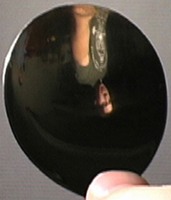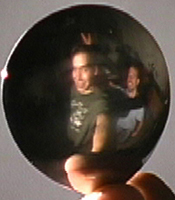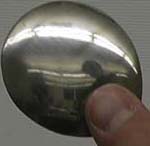|
|
|
|
| Seat Experiment |
| Polish both sides of your spherical mirror. Be careful with
this delicate, precision scientific apparatus.
Q1: Estimate by eye the radius of curvature for your mirror. |
| The
Concave Mirror:
Q2: Hold your concave mirror at arms length and describe the image of yourself in the mirror. Is it upright or inverted? What is the approximate magnification? Is the image virtual or real? |
 |
 |
Q3:
Move a finger along the principle axis towards the mirror vertex and
describe how its image changes. Does the image change magnification
and how? Does it disappear or invert and if so where? What is
magnification when the fringe is touching the spoon?
Q4: When your finger is at a distance R from the mirror it appears to have an M =-1.0, what are R and f for this mirror? |
|
The Convex Mirror: Q5: Hold your convex mirror at arms length and describe the image of yourself in the mirror. Is it upright or inverted? Approximately what magnification? Is the image virtual or real? |
|
|
|
Q6: Now move a finger along the principal axis towards the mirror vertex and describe how its image changes. Does the image change magnification and how? Does it disappear or invert and if so where? What is the maximum magnification? |
| Q7: Car side Mirrors often have "CAUTION: OBJECTS IN MIRROR ARE CLOSER THAN THEY APPEAR" etched on them (remember the movie Jurassic Park) Explain why. |
| References |
|
|
|
|

